Do-it-yourself high beds made of wood. Design of high beds from Igor Lyadov: photos of interesting options. What is best to plant
Spring for all summer residents and gardeners begins the same way: dig up all the land, divide it into beds, make a neat earthen roller for each. Then wait until the soil warms up, plant the plants and start fighting weeds that occupy the entire territory, including paths. But you can make improvements that will help you get more yield at less cost (labor, first of all).
Advantages and disadvantages of a high bed
Usually, having heard about the many advantages of such structures, people begin to wonder how to do it. How does it differ from ordinary landings at ground level? We list only the main advantages:
- The soil on your site can be absolutely any, this will no longer affect the crop. The tall structure can be filled with a general soil mix or suitable for a specific crop. If your dacha is located in a damp lowland, then drainage can be laid as the first layer: broken brick, then lay eggshells, branches and grass left after the autumn cleaning of the site, leaves and earth in layers.
- After many years of operation, the soil in the garden becomes less fertile, accumulates various pathogens. Having learned how to make a high bed, and installing it on your site, you can bring in fresh purchased soil and protect plants from rotting and fungi.
- In spring, such structures warm up faster, which makes it possible to plant plants earlier. This gives a chance to get two harvests instead of one.
- The yield is 2 times higher than when using flat beds.
- Convenience of care of a bed, and also collecting fruits of low-growing plants.
- Site space saving and aesthetic appearance.
Everything has its downside. The disadvantage of high beds can be called the need for material investments and labor in their creation. They dry out fairly quickly and require frequent watering. it won't fit. The limited space of the bed requires regular fertilization, as the soil is depleted.
What materials may be required to create a high bed
If you have only used flat beds so far, be sure to experiment with one progressive design. If we talk about how to make a high bed, the first question arises about the necessary material. The scope for creativity here is great, it all depends on the level of your skill and the amount you are willing to spend.
- Raised brick beds. If you do not have bricklaying experience, then the design may not come out too aesthetically pleasing. The advantages of this are long-term and safe use.
- High beds from boards. They are the easiest to make. You need to have at hand a sufficient number of long boards, corners, transverse ceilings. As an option, you can use slats that are sheathed with wood or the minus is obvious - the tree rots. Usually, an old slate is taken, which is removed from the roof during repairs. It is believed that this is a harmful material, but the only damage to health can be caused by the dust generated during its cutting. Minus - fragility and the ability to break the structure during garden work.
- Rocks and grout is a very creative approach to gardening. You can create designs for centuries, beautiful, durable, of arbitrary shape and size.
- Plastic bottles filled with colorful sand. Get the original beds with low sides.

Optimum bed height
Depends on the characteristics of the garden plot and planted crops. If the garden has good soil, you can make bumpers about 15 cm high. This will make it possible to solve the problem of weeds and soil diseases, make it easier to care for the bed and improve its appearance.
If the soil is poor and a high bed is created as a separately functioning structure, then it must be made higher, 30-90 cm. Sometimes a height is laid at the level of the belt, but then it should not be made wide.

Mounting
The arrangement of high beds is a creative process. Each gardener will get a completely unique work, but the main thing is that the goals are achieved, garden crops grow well and bear fruit, and the garden itself is convenient to maintain.
Choose a location. It may be the most trampled down and unsuitable for planting. Draw the size of the future design. The length can be any, and it is better not to make the width more than 110 cm. Drive in pegs around the perimeter, so you indicate the size of the beds.
Now decide on the material. If this is a tree, then it should be protected from dampness, varnished or varnished, and then assembled in the form of a box using corners and nails. Raised slate beds are even easier to create. Using a grinder, you need to cut the sheets into strips of the required width (70-80 cm), and then, having dug a narrow groove along the perimeter, deepen them one at a time and trample them tightly. You can give strength to the structure using the same corners, in addition, you need to tighten it around the perimeter with steel wire.

Filling the beds
We proceed from the fact that the height of your bed is 80-90 cm. Put a wire mesh at the very bottom so that your vegetables do not fall prey to moles or shrews. Then about 25 cm can be occupied by all the waste of your personal plot: uprooted stumps, large branches. For better drainage, large pieces of brick can be added here.

The next layer is 40-50 cm. This is a source of minerals and fertilizers. It can be small chips, grass, wood ash, lime, food waste (vegetable peelings, etc.). It is also worth adding rotted manure and compost, bird droppings with straw.

On top of a layer of 10-20 cm, you need to lay high-quality garden soil. It is not necessary to mix the layers, it is enough to pour them abundantly and give time for shrinkage. The device of high beds is not as difficult as it might seem from the outside, but absolutely amazing results are achieved.
Irrigation Features
The design features are such that it absorbs more heat, and therefore consumes a lot of moisture. High is well suited. Since the soil temperature here is almost 10 degrees higher, this stimulates the growth and development of the root system. In addition, this culture loves light and fresh soil and does not tolerate wetlands. But don't let the soil dry out. If it is not possible to install, water several times a day, especially in hot weather.
The effectiveness of these designs is so high that, having put one as an experiment, you will soon decide: do high beds throughout the area.

Raised bed in spring and autumn
In the autumn, after harvesting, you may notice that the level of the earth has dipped a lot. Collect a new layer of organic matter (plants, branches, grass, fertilizers), lay it on the garden bed and cover it well with high-quality garden soil. If you still have not seen high beds live, the photo will help to present all the details. You don’t need to dig, you just need to water and cover with a film until the new year. In the spring, as soon as the snow melts, your garden bed will be ready for planting the first plants. It can be greens and radishes, which will later be replaced by cucumbers, tomatoes or cabbage. The high location will save the plants from quite strong spring frosts, and the good heat transfer of the beds stimulates rapid growth and abundant fruiting.
What is best to plant
The temperature of the soil of a high bed is always higher than the surrounding land. This is facilitated by the limited space, and the elevated location, and the decomposition of organic matter, which is crammed with the structure. In the first year of use, it is better to plant "gluttonous" plants that like excess nutrients. These are tomatoes, pumpkin, cucumbers, cabbage. Only in the second year, you can grow root vegetables, herbs and leafy vegetables. But even now the soil temperature will be much higher, which will allow harvesting sooner.
Summing up
Now you know how to make a high bed, and you can put it into practice on your site. A minimum of hassle, affordable materials, and the result is a neat garden without weeds and excellent vegetables that have ripened at least a month earlier. That's a strong enough motivation to try.
High beds in the country - the trend of organic farming. It is convenient to take care of them, they contribute to obtaining a larger (compared to "flat" beds) crop. This is a great option for both beginner gardeners and experienced gardeners.
Before you start building a high bed, decide on the place where you will place it. Orient the bed from north to south so that the sun's rays illuminate it well. Any non-shaded flat spot will do.
Pros and cons of high beds
So let's start with advantages of installing a high bed in the countryside. We list the main ones:
- the first plus follows from the very name of this type of beds: it is convenient to process high beds due to the fact that they rise significantly above the ground. There will be no need to strain your back once again, which means that the pain will be less disturbing (this problem is relevant for many avid summer residents);
- It doesn’t matter at all what the soil is on your site: if necessary, high beds can be filled with fertile soil bought in a store. It will also not be difficult over time to replace the depleted soil with a new one, thereby preventing the appearance of diseases in plants;
- since the raised bed is located above ground level, with the advent of spring it heats up much faster than a regular bed, and you can plant seedlings (or sow seeds) in a high bed much earlier, and the harvest will be larger;
- aesthetic appearance: you can decorate the box for the beds in accordance with your taste (and, of course, possibilities). A garden with high beds looks neat, compact and attractive;
- reduction in the frequency of digging and weeding: it is difficult for weeds to penetrate into the box of a high bed;
- due to good drainage, water does not stagnate in high beds, and the box will not allow water to spill onto the garden path.
Significant advantages, it would seem, make high beds "dream beds", but, as you know, there are spots in the sun, so let's talk about the disadvantages of such structures. Main cons of high beds:
- the soil in high beds dries out quickly, watering needs to be done more often, so it is not recommended to build such beds on hills. This problem can be dealt with by deepening the bed by 20-30 cm or by mulching the soil. You can also organize automatic watering;
- since the space in the high bed is limited, the plants will have to be fed with fertilizer more often than when using ordinary beds;
- arranging a high bed often requires certain material investments and physical costs.
And yet, the advantages "outweigh": given the features of high beds, serious problems should not arise.

What are raised beds made of?
For a high bed, a fence is simply necessary. This can be a box (purchased or made by hand) or individual sheets of material (for example, flat or corrugated slate).

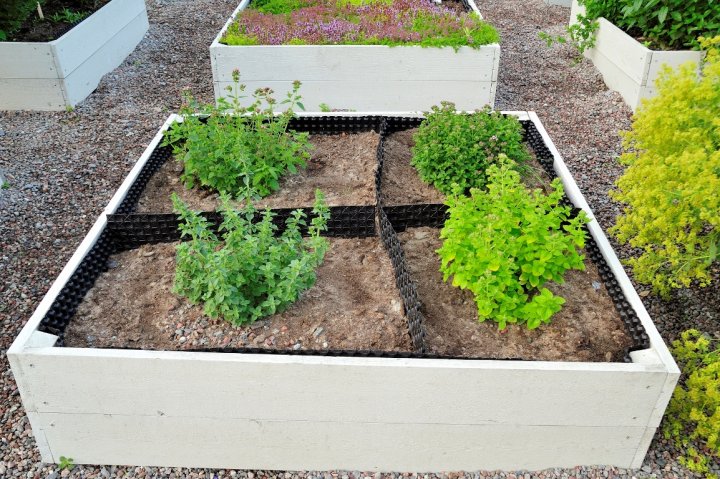

The choice of material depends on your capabilities and desires. As a rule, for the manufacture of high beds use the following materials:
- brick: requires certain skills in masonry, but is safe and durable;
- wood (boards, beams): the easiest option to install, but wood is susceptible to decay, so it must be treated with an antiseptic;
- slate (asbestos-cement sheets): accessible, harmless (if you protect the respiratory organs from dust when cutting), but fragile;
- plastic: durable, moisture resistant, decorative, low cost.
We invite you to watch the following video detailed instructions for the manufacture of a wooden box for a high bed:
How to make a high bed with your own hands
The optimal dimensions for a high bed are 1 m wide, 1.8-2 m long and 30-90 cm high (in a plot with fertile soil, the height can be reduced to 15 cm). If you want to make the bed taller, reduce its width - it is more convenient to care for a narrow high bed.



To build high beds with your own hands from boards, first prepare the following tools and materials:
- a hammer;
- screwdriver and screws;
- shovel;
- level;
- roulette;
- wooden beams or boards of the required width (more precisely, height, because we are talking about future sides of the garden);
- nutrient soil (fertile soil mixture);
- wire mesh according to the size of the beds;
- organic waste (vegetable peelings, sawdust, foliage);
- coarse plant waste for drainage (branches, boards, stumps, pieces of brick).
Now proceed with the following steps:
1. Clean the area where you plan to place the garden bed from the sod.
2. Mark the area according to the size of the future beds using a tape measure.
3. Install the bars (or boards) according to the markup, check the dimensions, fit the bars closely with a hammer.
4. Fasten the bars with self-tapping screws and a screwdriver.
5. Line the bottom of the bed with wire mesh so that rodents and other pests cannot get close to the roots of plants.
6. Place materials prepared for drainage (branches, bricks, etc.) on the grid.
7. The next layer is organic waste.
8. Pour nutrient soil into the bed, level it. The bed is ready!
Very detailed and understandable about how to independently make high beds from slate is described in the video:
High bed care
In order for the raised bed to last as long as possible, this structure must be properly looked after. If in the autumn you notice that the earth in the box has sagged (and most likely it will - this is a natural process), put the required amount of organic waste in the bed, cover it with nutrient soil. It is not necessary to dig up a high bed, and in the spring you will receive a convenient fenced plot of land, ready for planting greens, radishes, cucumbers, tomatoes and other vegetables.
By installing high beds on the site, you will get a well-groomed garden, make your "dacha life" easier (by reducing weeding and digging), and, of course, you will be delighted with a wonderful harvest!
Growing your own vegetables and fruit trees is becoming more and more popular. Many city dwellers acquire small territories outside the city and build houses with vegetable gardens and greenhouses there. Do-it-yourself high beds in the country house look very attractive, photos of which are given in the article. The creation of such structures has a fruitful effect on increasing the yield, while creating a unique design on the backyard territory.
Why do they use high beds in the country with their own hands: photos of finished structures
High ones are not only a decoration of the territory, but also reduce soil moisture, therefore, in an area with a close flow ground water such structures are essential. Often they are erected in greenhouses for the convenience of caring for plants.
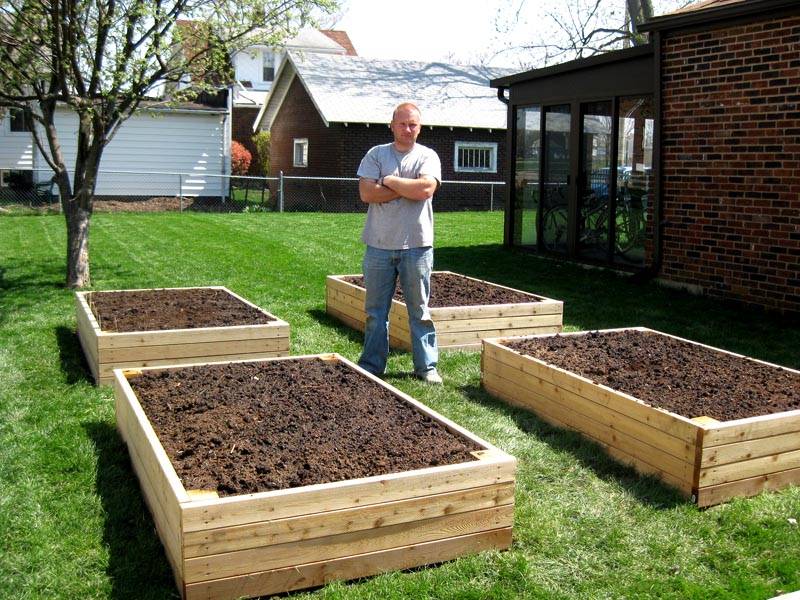
It is easy to create high beds, it is enough to determine the size and height of the structure, as well as choose the material of manufacture:
- wooden models. The most common option, however, should not be forgotten about the need to treat wood from the formation of mold and fungi.

- plastic structures. Attracts cheapness and ease of care for the material. It is environmentally friendly and does not require special treatment.
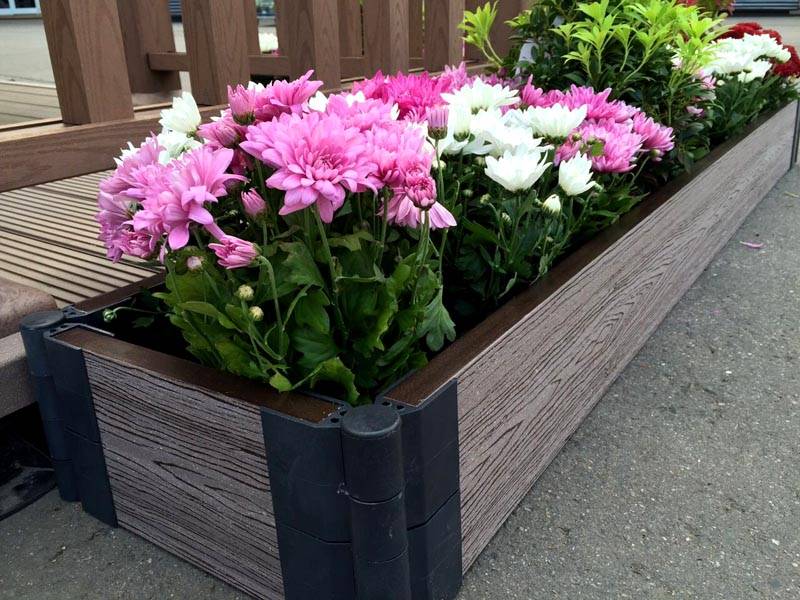
- Galvanized metal. The strength and durability of the material attracts a lot of attention to it. When choosing galvanizing for the construction of high beds, do not forget that the material heats up quickly in the sun, so it is suitable for shady areas.
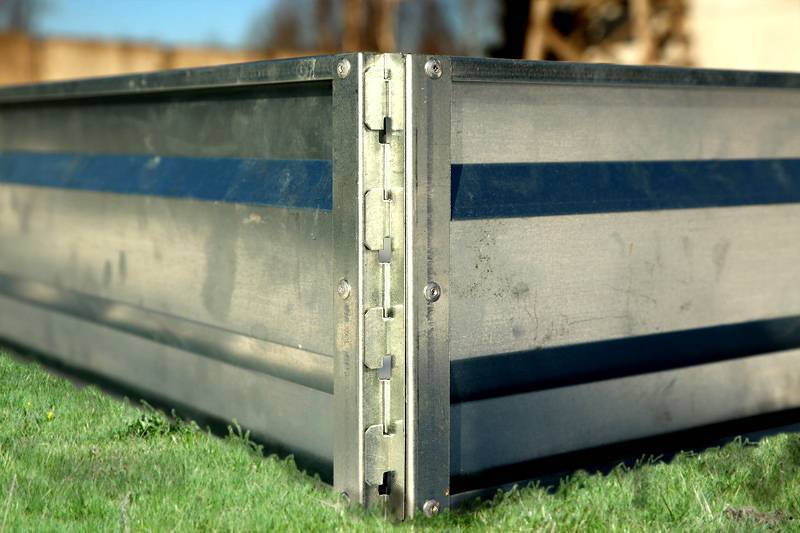
- Concrete or brickwork. Used in the garden by craftsmen who work great with stone. It is not easy to create such a ridge, since you need to know all the features of the masonry, as well as cheap solutions. concrete structures do not apply.

- Handy materials."Homemade" turns into almost any improvised means. Available in plastic or glass bottles, constructions with several floors from used tires and much more.

Choosing a fencing model and material for work is based on the characteristics of the climate, material capabilities and the requirements for the final appearance.
Pros and cons of high beds at their summer cottage
High beds for strawberries and other crops have a whole range of advantages:
- you can arrange a garden even on uncultivated areas;
- no need to dig the entire territory, it is enough to loosen the earth inside the structure;

- weeds grow less and are easier to weed;
- neat paths are made between the ridges, along which it is convenient to walk even in bad weather;
- the rate of ripening of the crop increases, as the soil warms up faster;
- with proper arrangement, high beds with sides have a drainage layer;
- easier to insulate structures for the winter.
It is not difficult to assemble such models. Decide in advance on the location, height and material of the fence for high beds. Here are some interesting photo examples of garden design using such structures:
1 of 4


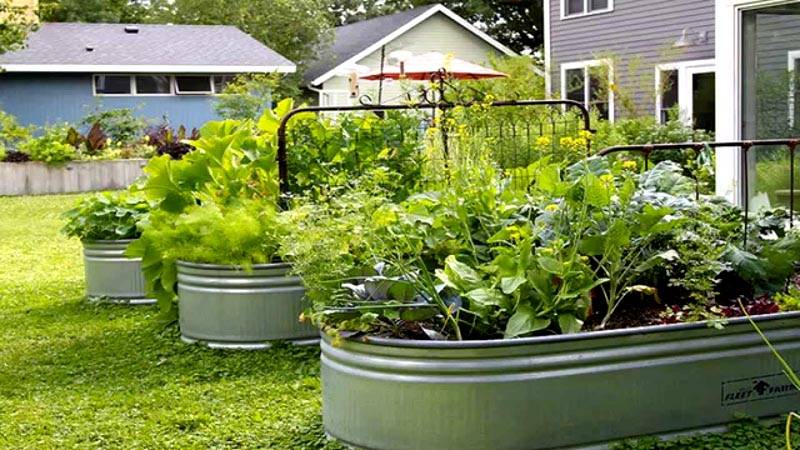

Ways to make a high bed in the country with your own hands
When creating, you need to decide on several parameters:
- Dimensions. It is necessary to calculate the amount of material needed in advance, and this can only be done after creating drawings with exact dimensions.
- The form. They create square, rectangular, round or multi-level structures for planting useful crops.

- Manufacturing material. The most common and affordable are wood, galvanized and, of course, plastic. Stone ones will be more expensive, but they will also last until they get bored.
There are options for high beds and without fences, but they will not protect the land from sprawl due to heavy rains or melting snow. Therefore, it is better and more reliable to buy boards for high beds or other available material.

To choose a model of the ridge, decide on the type of plants for planting. For example, create a multi-tiered strawberry garden with your own hands. Here is a video example of its assembly:
Features of high beds: photo examples of designs from various materials
Creating fences for high beds on the site is easy. Having chosen the dimensions and location, carefully read the advantages and disadvantages of all options:
| Material with photo example | Advantages | Flaws |
Wooden structures  Purchasable Options Purchasable Options |
|
|
Metal variant 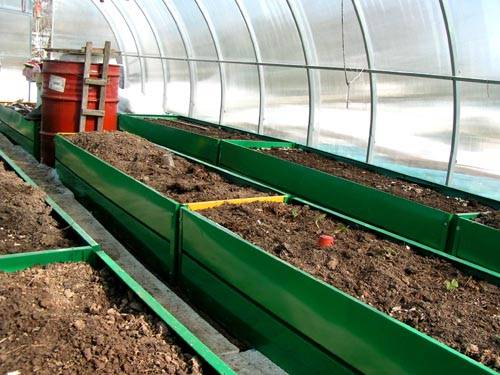 |
|
|
and panels 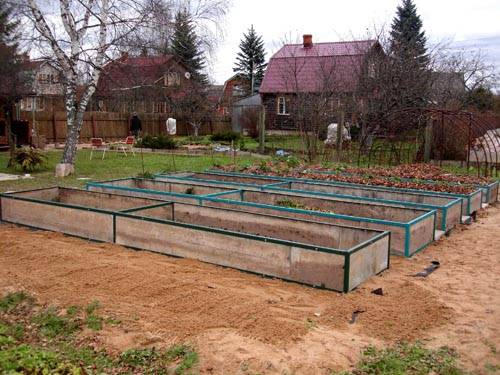 Application plastic panels in the garden Application plastic panels in the garden |
|
|
Concrete or brick fences  An interesting option for arranging a flower bed An interesting option for arranging a flower bed |
|
|
Homemade beds from improvised materials  Application of plastic bottles Application of plastic bottles |
|
|
Of these options, a high bed made of plastic panels is popular. It is easy to mount, and the variety model range allows you to find best option for any household area. Here are some photo examples of such structures:
1 of 4
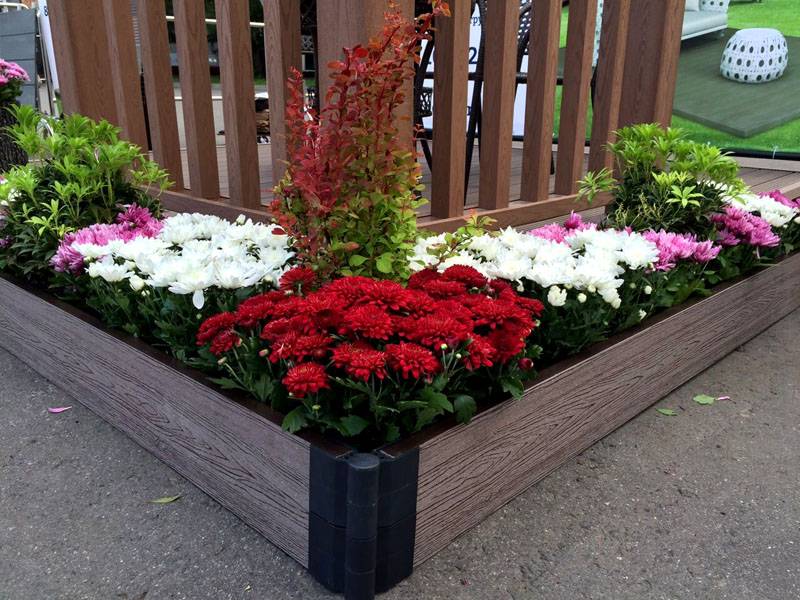
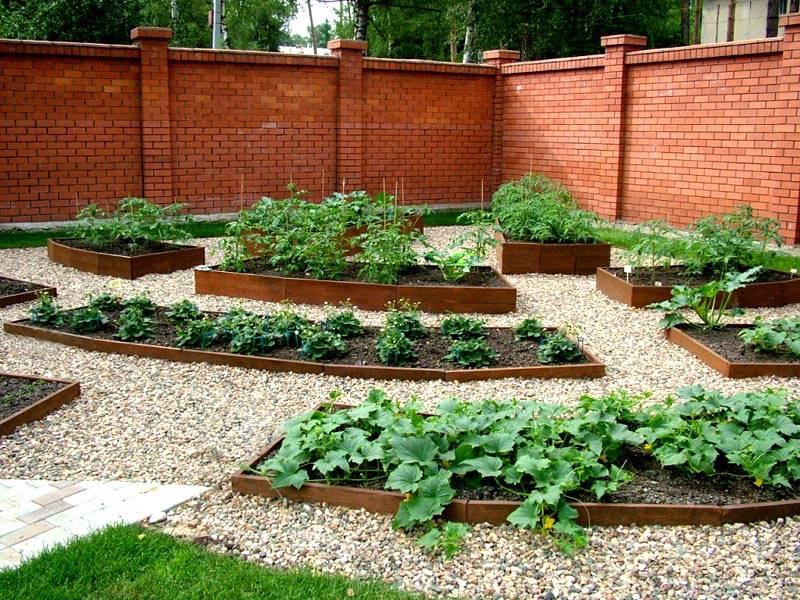

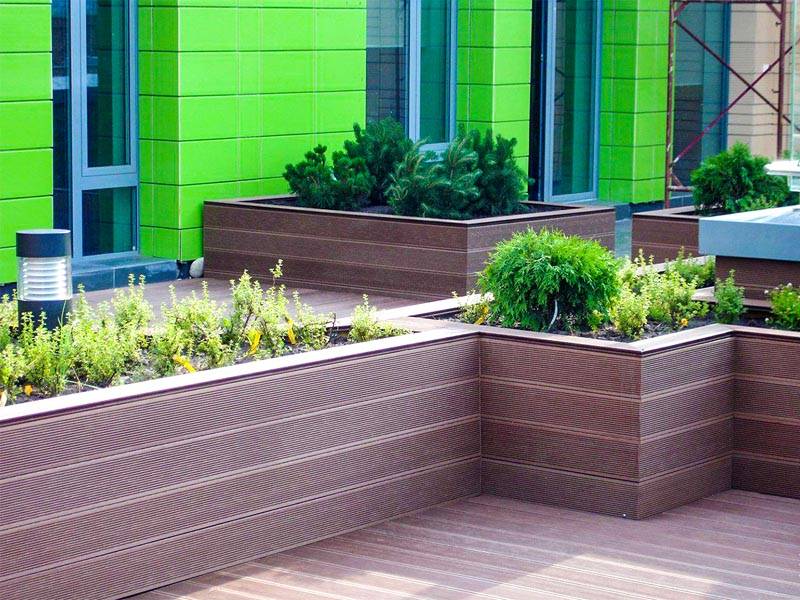
It is easy to make a high bed of slate with your own hands. To do this, just follow a few simple steps:
- Purchase sheets or take pieces of material remaining from the roof.
- Dig a small trench along the perimeter of the future bed, half the height of the fence.
- Install the slate sheets vertically and dig them tightly with earth.
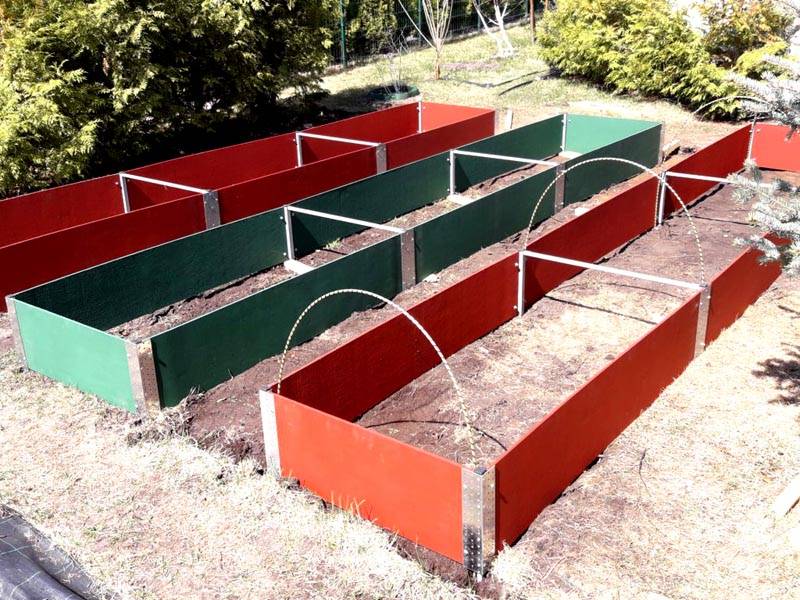
Additionally, you can use metal or plastic pegs for the strength of the structure. And also do not forget about safety precautions and work with the material with gloves.
Design of high beds from Igor Lyadov: photos of interesting options
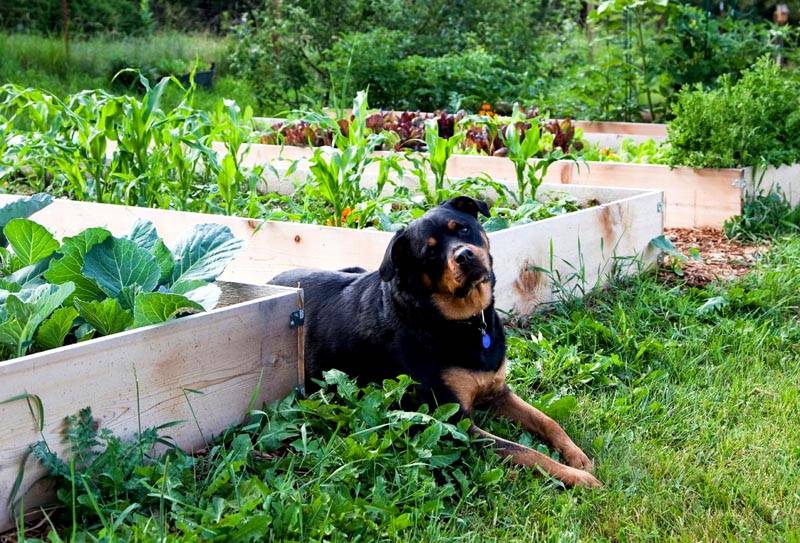
Creating a "smart garden" using this technology implies the following dimensions: width from 60 to 100 cm, and the length is not of fundamental importance. The gardener advises to arrange the construction from north to south, leaving a passage between the ridges from 60 to 80 cm. Updating the box should be done every 5-7 years.
The creation technology itself comes down to several points:
| Illustration | The sequence of creating a structure |
 | On a heavily overgrown area, it is worth mowing the grass, but not burning it, but laying it down. Make sure that the surface is even for the future ridge. |
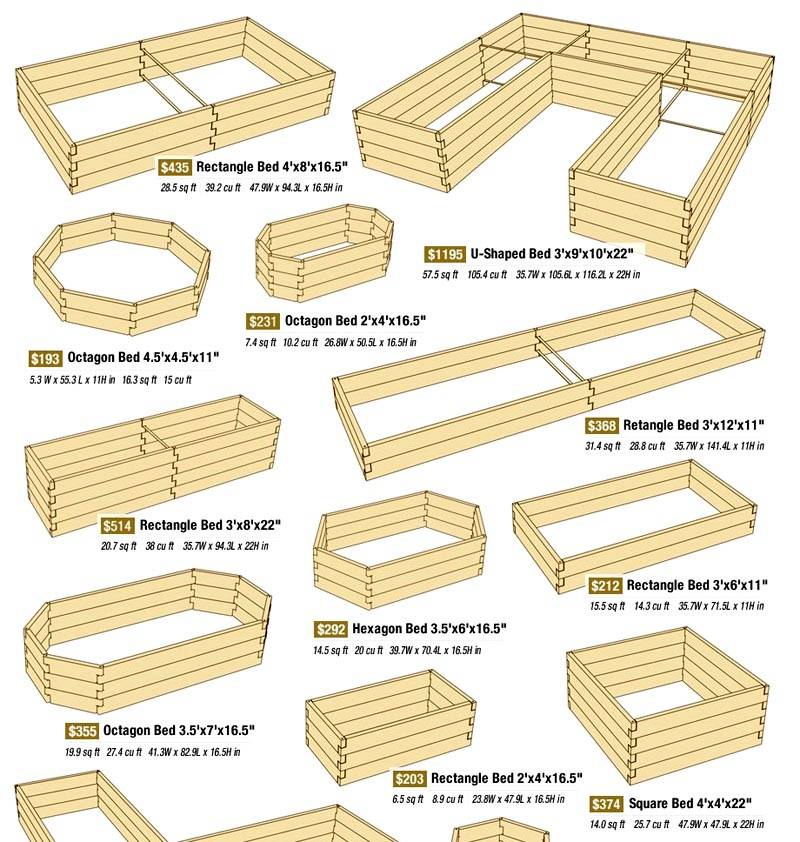 | Put together a box of boards or other material, fastening it with self-tapping screws. Cover the bottom completely with open cardboard boxes. Then, pour a thin layer of sand. |
 | The next layer will be from fallen leaves, mowed grass and other plant remains. Before backfilling all the elements, it is better to paint the structure with water-repellent paint. |
 | Add humus, manure and compost according to the gardener's recipe. And 10 cm of earth. |
Below is a video on creating a garden bed from Igor Lyadov:
Do-it-yourself high garden: how to make a wooden structure
With the help of wood create a unique design of beds on suburban area, photos of several options are given below:
1 of 4




To make a bed of boards with your own hands according to a photo or a prepared drawing, you need to collect:
- the material itself to work the desired length;
- antiseptic to protect against rot and mold;
- wood saw;
- hammer and nails;
- pegs to strengthen the structure.

The site for planting is prepared in advance. It is better to make markings using pegs and ropes to get an even shape and the same height of the structure from all sides. Step-by-step instruction for assembling the box is shown in the video instructions below:
Features of do-it-yourself vertical beds: photos of interesting options
Popular among professional gardeners and just lovers of "digging in the ground" are not only warm high beds, but also vertical multi-level structures. This planting option has a number of advantages:
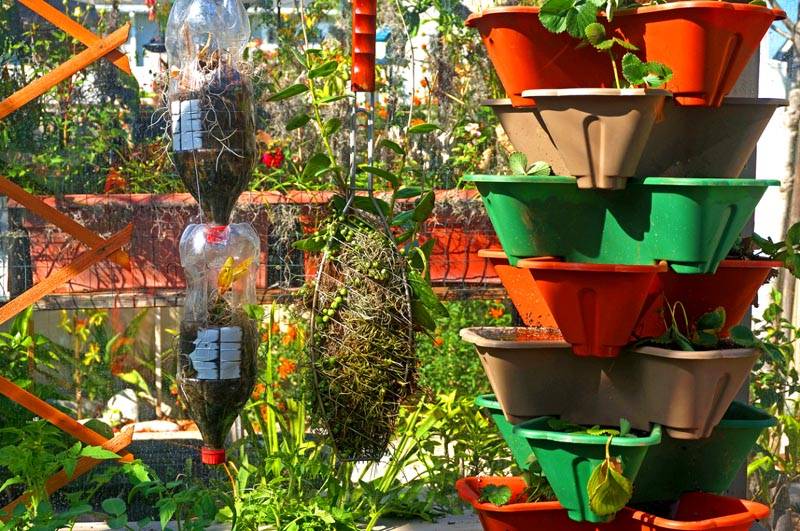
- it is more convenient to cultivate the soil around the plants, since there is no need to bend down low;
- less likely to spread fungal diseases: there is no contact with the rest of the soil;
- you can bring the structure into the house for a period of cold weather or other bad weather;
- you can decorate or decorate the wall of any structure;
- there is a lot of free space for planting other crops.

However, there are also disadvantages in choosing vertical bed models:
- a small amount of fertile soil leads to the need for top dressing;
- the soil dries out faster, so it is needed more often;
- not all crops are recommended to be planted in vertical structures.
They raise beds with strawberries or cucumbers from the ground, as these plants are considered unpretentious in care. And warmth and constant watering have a fruitful effect on the level of yield.
Here are some interesting and unusual vertical beds:
1 of 4

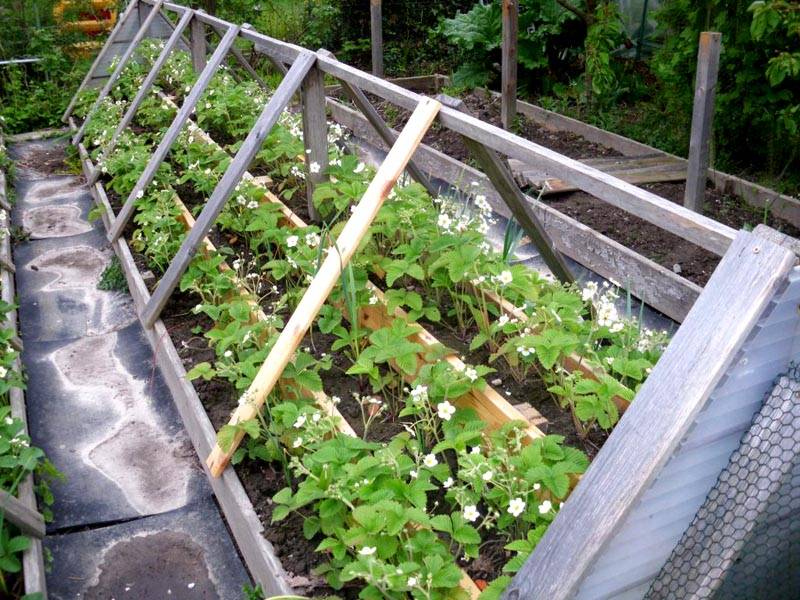


Where to buy a vertical bed for strawberries: several models with descriptions and photos
By design, vertical beds are different. On sale in online stores and specialized departments of shopping centers there are pyramids, suspended structures, multi-level and other unique ideas. Here are some photo examples:
1 of 4

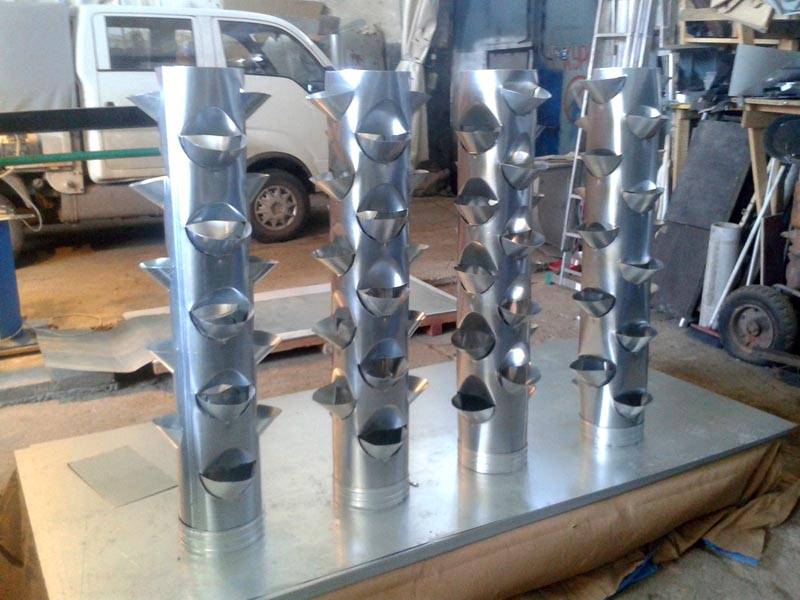


The cost of the model varies depending on the material of manufacture, the amount of area for planting and the complexity of the design itself. Below are a few options that are available for purchase in stores:
| Title with photo | Short description | Cost, rub. |
 Openwork Openwork | The package includes 3 pots, 13 cm high, 37 cm in diameter and 3.5 liters in volume. | 1200 |
 Pockets for green walls Pockets for green walls | Dense waterproof material. Includes 36 pockets. | 1450 |
 Pyramid Pyramid | Construction height 150 cm, length - 127 cm, width 100 cm. Material - plastic. | 4700 |
Maria, Kaluga:“I bought the Azhur design at first for the balcony, but then I appreciated all its charm in the garden. I plant strawberries and herbs, they grow beautifully, without taking up much space.
Olga, Moscow:“I decided to decorate the wall of the house in the village with fresh flowers, but I was afraid to plant it. Found this great option. I put pots or bags with earth and a flower in pockets for green walls, it looks great.
Dmitry, Saratov:“I like to live in the country in the summer, so I spend a lot of time in the garden. I decided to make myself a bed for strawberries, and did not come up with anything better than making it vertical. I found the Pyramid model, assembled it quickly, and now I get a high yield every year.”
You can not only buy a ready-made structure for vertical planting of plants and flowers, but also make it yourself. Several productive and simple ways will be given below.
Optimal dimensions of a pyramid-bed for strawberries with your own hands: video assembly instructions
Pyramid garden beds are becoming more and more popular among gardeners. They reduce the occupied area and give high yields of certain plant varieties. For example, such models are often used for planting juicy strawberries.

You can make pyramidal beds of any size and from improvised materials. Dimensions are determined only by your preferences. For example, if the area allows, you can build a multi-level flower bed with a large base. With a small space for planting or growing strawberries on terraces, you can mount a tall model with a small base.
Here are a few interesting options do-it-yourself country pyramids:
1 of 4



![]()
Step-by-step video instruction for creating a wooden pyramid:
How to make vertical beds for strawberries from plastic pipes
Create a vertical garden plastic pipes on the site under the force of any summer resident who knows how to handle the tool. There are quite a few advantages to this landing method:

- ease of use and ease of harvesting;
- no need to often dig and fertilize the soil;
- in addition to a high yield, such designs look beautiful on any site;
- rodents do not harm the root system, and the soil quickly warms up in the sun, increasing productivity.
The disadvantages include only the need for frequent watering.
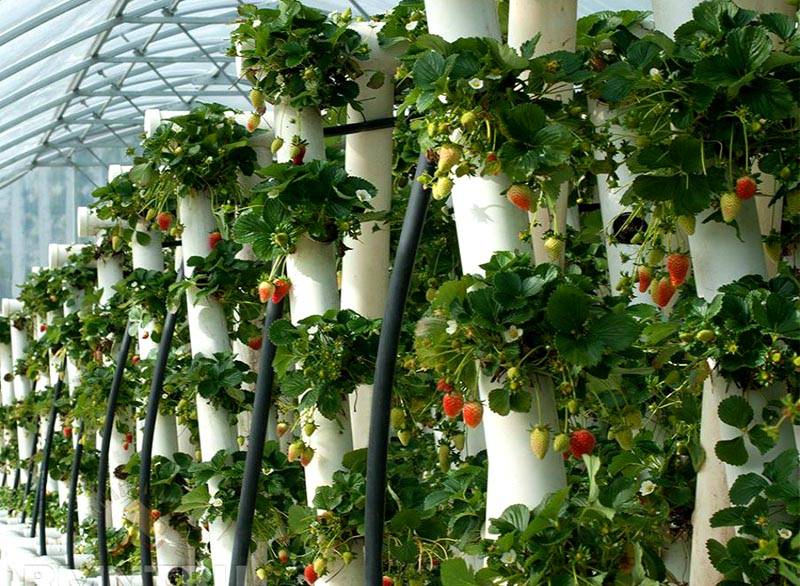
To make a garden bed of PVC pipes with your own hands, prepare:
- thick PVC pipes with a diameter of 15 cm;
- thin pipes and plugs;
- chisel, drill and hacksaw;
- a large canvas of burlap;
- reinforced tape and a skein of synthetic twine;
- soil for plants.
To assemble a vertical bed, follow the instructions below:
| Illustration | Sequencing |
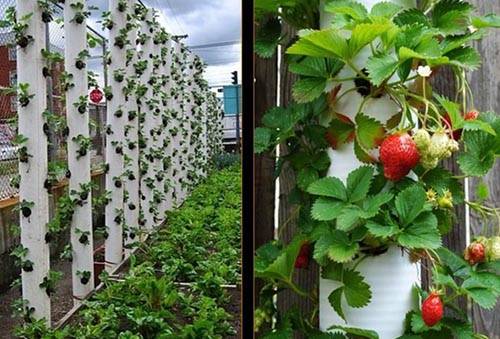 | Select the appropriate bed height and cut the required piece of pipe. From a thin one, cut a piece 10 cm less than the height of the structure. It is necessary for uniform watering. |
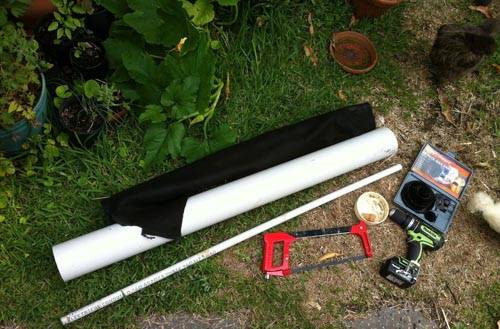 | On top of a small PVC pipe, 2/3 of the entire height, make several holes at the same distance. Through them, water will flow to the top layer of the soil. Install the cap at the bottom. |
 | Take a hole saw and make holes in the large plant pipe. The diameter of the nest should be 15 cm, and the distance between the “holes” should be 20-25 cm. Place a plug at the bottom of the pipe and fix the structure vertically. |
 | On the bottom, fill in a layer of drainage 10 cm high, then install a thin pipe and lay fertile soil. Your garden is ready for planting. |
To make it easier to understand the assembly sequence, watch the video instruction:
How to make a vertical garden bed with your own hands from a building grid
For berries and cucumbers vertical bed- a suitable solution for arranging a garden. A simple option for creating fences is to use construction mesh, which is easy to buy at a specialized store at an affordable price.

It is necessary to choose a piece of material along the circumference of the future ridge. The mesh is fixed with metal wire to make a pipe. After assembly, it is enough to install the structure in the chosen place and fill it with fertile soil.
AT last years many gardeners erect high beds on their plots, also called bulk or raised beds. What do these beds look like? As a rule, bulk beds are created by constructing frames of various shapes and types. A substrate is placed inside them, in which cultures grow. And between them they lay paths that need to be strengthened and covered with something. The topic of this article is high beds: pros and cons. From it we learn whether it is really necessary to do them.
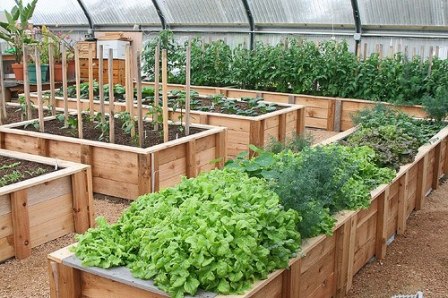
Raised wooden plank beds
Raised beds - how are they made?
You can create high beds from materials such as:
- concrete;
- bricks;
- plastic materials;
- wooden structures;
- slate.

Benefits of raised beds
High beds, first of all, are good because they warm up very quickly. This is especially evident in early spring, when the rest of the earth is still cold and full of excess moisture. The better suited are high beds for such a site where a reservoir is located nearby. And for regions with a cold and long spring, hanging beds will be an excellent way out.

Other benefits include:
- Excellent germination. Due to the fact that the soil is already well warmed up, the result on such a bed will be more effective than on a regular one. The roots of such plants are always enriched with additional oxygen, they are warm and dry. This means that the cultures themselves grow and develop faster, besides, they are stronger than their counterparts in the garden that live on other types of beds.
- In warm soil, all processes pass faster, it heals earlier after winter, and besides, it has fewer pathogens of plant diseases.
- In early spring, it is not at all difficult to build a greenhouse over high beds, which will be located on small arches.
- A high bed can always be filled with new soil - thanks to which, on such land there will be an excellent harvest of any planted crop.
- Such beds look very beautiful and impressive; climbing plants, for example, strawberries, can be successfully placed on them.

Disadvantages of high beds
The main disadvantage of high beds is that they, in view of the constant supply of oxygen, dry out quickly enough and need to be watered very often. The way out in this situation is to use mulch, which will not allow water to evaporate very quickly. Compost fertilizers are not very suitable for high beds, because in them all processes are faster. So, despite the fact that diseases are unlikely to linger here, the seeds of plants themselves may also not germinate very well.

In addition, on the high beds, the bear lives perfectly all winter. If on ordinary beds it is unlikely to endure the winter, then on high beds it will have to be fought additionally. As a rule, the same crops are planted on such beds from year to year, which means that the principles of crop rotation will not be observed. As a result, the earth will be depleted and poor in useful substances and minerals. A lot of labor and finances have to be spent on the arrangement of high beds. In addition to arranging the beds themselves, there is a need to fill the paths between them, which entails regular expenses.

Now you know everything about high beds. Pros and cons described in this article will help you make the right decision and get good results. All the efforts and costs that go into their creation will quickly lose their significance as soon as undeniable advantages become visible: excellent access to sunlight for crops, great value of the soil, and as a result, an excellent harvest.
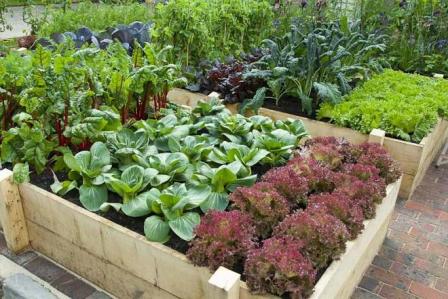
See also video:
Raised beds: pros and cons
- We reveal the secrets of the "lazy man's garden", ...
Cultivated plants growing in garden plots provide their owners with a large amount of very useful nutrients and vitamins. And what kind of nutrition should gardeners provide plants in order to have a good harvest? Sunlight, heat, irrigation, fertilizer and good soil. And good soil is called soft, crumbly soil with a high content of humus.
What to do if the land near the cottage is not at all like that. Somewhere heavy clay, somewhere sand with stones. The only way out in this situation is high beds that can be poured onto any flat surface.
What is the advantage of high beds over ordinary ones, and what are they? A high bed is a bed with a height of more than 10-15 cm if the soil below is normal, and more than 30 cm if the base is not suitable for plants.
 Its main advantages include:
Its main advantages include:
- you can plant plants in any area, even rocky;
- it is easier to work with plants - no need to bend deeply;
- the bed warms up faster in the sun, which means you can plant plants and harvest earlier;
- it is easier to cover with a film greenhouse or agrofibre;
- plants are not afraid of heavy rains, thanks to natural drainage;
- you can make wide paths between the beds - it is convenient to walk and work with the beds;
- the area is becoming cultural.
By itself, the principle of beds or ridges is used in the cultivation of almost all garden plants. When sowing large fields, the ridges are created by a tractor. They can be of different widths, depending on the type of plants. Any ridges are needed in order to improve the supply of oxygen to plants, systematize weeding, and protect against waterlogging. You need to be objective when evaluating the pros and cons of high beds before you start building them.
Building one high bed of boards, plastic panels or bricks with your own hands will take as much time as digging three ordinary ones.
In addition, during the drought period, every 10 cm of high beds will need an additional 5 liters of water per meter of area, when watered. If a high bed has already been built, then you will only have to work with the earth hand tool, walk-behind tractor or cultivator will not drive into such a bed. To make high beds with your own hands on a plot of more than 10 acres - few people will gather. When the plot is small, and you want to have a large crop, high beds will be the right decision.
Types of fences for high beds
 The most common and cheap option- make high beds with your own hands from boards. Wood is easy to process and does not contain harmful substances. But it quickly rots on contact with the ground. You can treat the wood with a special impregnation, the antiseptic contains substances that are poisonous to insects and microbes.
The most common and cheap option- make high beds with your own hands from boards. Wood is easy to process and does not contain harmful substances. But it quickly rots on contact with the ground. You can treat the wood with a special impregnation, the antiseptic contains substances that are poisonous to insects and microbes.
Wattle and twigs are also not durable, but a beautiful option. To do this, you need the skills of such work. Using stones or bricks will make the bed very durable. The disadvantage is the high cost of bricks and decorative stone, although in some places this material is easily found in a quarry or landfill. In any case, the work is not fast and hard.
Plastic ones are already on sale in many hardware stores. They cost more than simple boards, but are more durable. Plastic strips are relatively soft and require more posts to attach. Metal fences are stronger than plastic ones, but they rust without high-quality processing. The cost of metal is comparable to the cost of plastic. Concrete fences are a very durable and reliable option, but one of the most time-consuming. It will require the construction of formwork, the installation of metal reinforcement, kneading and pouring the solution.
A very simple and durable option is do-it-yourself slate beds. You can use the cheapest wavy, or you can use a more durable and beautiful even sheet. Slate is a rather fragile material and will require additional pegs. It is easy to cut with a grinder, but its dust contains asbestos, which is banned for use in many countries of the world. Since wooden structures are the most common option, in this example, it will be considered how to make high beds from available materials.
DIY wooden fences
 The durability of the structure depends on the thickness of the boards. But in order to save money, you can also buy the cheapest boards 25 mm thick, fourth grade. It is better to plan the arrangement of high beds with your own hands in advance, and immediately decide on the desired height and size of the beds.
The durability of the structure depends on the thickness of the boards. But in order to save money, you can also buy the cheapest boards 25 mm thick, fourth grade. It is better to plan the arrangement of high beds with your own hands in advance, and immediately decide on the desired height and size of the beds.
For example, it was decided to build a bed 3 meters long and 1 meter wide, 30 cm high. It is necessary to saw off the boards of the desired length and put them together with small crossbars. It is better to do this on a flat horizontal platform. Having knocked together 4 shields, you can take them to the location of the beds. For connection at the corners, bars 50x50 or metal corners are used. If thick boards are used, you can do without additional corner fasteners, and use long nails or self-tapping screws. If the bed is more than 3 meters, it is worth using additional crossbars every few meters. To fix the beds to the ground, wooden or metal pegs are hammered.
The high beds of Igor Lyadov have gained great fame - the design of the beds is well suited to buildings made of logs. For the longitudinal walls, bark-free tree trunks are used. The length can be very different. Across the beds, they are hammered together with boards 60-150 cm long. Logs are a cheap material, and they can maintain strength for more than 10 years.
Filling high beds
 The sequence of filling is the secret of how to make high warm beds correctly. To protect plants from rodents and moles, the very bottom of the beds can be covered with a fine building net, pinned to the bottom of the walls. Lay a layer of geotextile on top of the mesh, which will protect the beds from weeds and prevent the fertile layer from deepening. To protect against weeds, for a while, old cardboard is also suitable.
The sequence of filling is the secret of how to make high warm beds correctly. To protect plants from rodents and moles, the very bottom of the beds can be covered with a fine building net, pinned to the bottom of the walls. Lay a layer of geotextile on top of the mesh, which will protect the beds from weeds and prevent the fertile layer from deepening. To protect against weeds, for a while, old cardboard is also suitable.
Next, you need to make a layer of drainage, it can be small branches, tree bark, large chips, leaves. Then you can lay a layer of grass, preferably without seeds. The grass will overheat, releasing heat. Over time, it will turn into a fertile layer. The next fall asleep humus from manure, bird droppings or compost. If necessary, add mineral fertilizers. A layer of good fertile soil is poured upstairs, in which seeds or seedlings can be planted. High do-it-yourself almost ready. It is necessary to make the layers equal, about 10 cm each. Mixing the layers or digging up the garden bed is not necessary. For the top layer, you can buy soil from a mixture of peat and humus. At the end of the work, the garden bed is abundantly watered. The raised bed is complete.
To reduce the evaporation of moisture and counteract the growth of weeds, you can close the high warm beds with dark agrofibre.
Weed control in this way is especially relevant when growing perennials. And the most popular perennial in the garden - it's strawberries.
Strawberries in high beds
 How will strawberries feel in high beds? Great, and collecting it is a pleasure. This berry really does not like waterlogging of the soil; it is almost impossible to harvest a good harvest in the lowlands. There is a way to make high beds for strawberries with your own hands without using hard building materials.
How will strawberries feel in high beds? Great, and collecting it is a pleasure. This berry really does not like waterlogging of the soil; it is almost impossible to harvest a good harvest in the lowlands. There is a way to make high beds for strawberries with your own hands without using hard building materials.
It is better to start arranging a plot for strawberries in the fall. Choose a well-lit area 150-200 cm wide, of any length. It is necessary to remove the sod layer, about 10 cm. Coarse organics (tree branches, hard grass) 60 cm wide, up to 20 cm high are poured into the center. On top - succulent plant remains with a layer of 15 cm. You can use several rows with layers of straw. Soddy soil and another 15 cm of fallen leaves are poured on top. Next, a layer of humus or compost. Above is fertile soil. All layers are well watered. The total height of the beds can reach up to 50 cm. And so they leave until spring.
In the spring, the bed is completely buried with a special non-woven material. From above it is necessary to make two rows of slots into which strawberries are planted. Since it is not difficult to make high beds for strawberries (no need to build anything), you can harvest a very good crop. Moreover, strawberries will not need to be fed, they will have enough nutrients from the decomposition of compost. But it is necessary to water very plentifully.
Raised beds in small areas
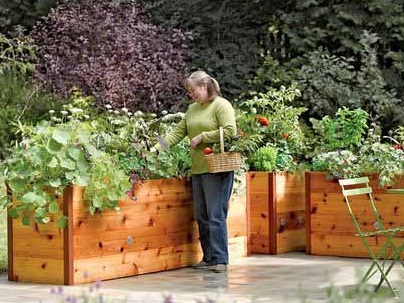 Many gardeners have gardens no more than one or two acres. It is they who need high beds in the country. Thanks to the excellent conditions for plants, you can get a bountiful harvest. The smaller the area of the site, the higher you need to make a bed. Many manage to grow two crops a year. How to make high beds in the country, and grow a bag of potatoes from one square meter? The proven method has long been known.
Many gardeners have gardens no more than one or two acres. It is they who need high beds in the country. Thanks to the excellent conditions for plants, you can get a bountiful harvest. The smaller the area of the site, the higher you need to make a bed. Many manage to grow two crops a year. How to make high beds in the country, and grow a bag of potatoes from one square meter? The proven method has long been known.
First, a square bed is made 1 m wide, up to 20 cm high. 4-5 potatoes are planted at the bottom. When the bores begin to appear from the ground, but before the green leaves open, the sprouts are covered with a layer of earth and put another layer of boards 10-20 cm. You can plant 4 more potatoes. And so do 3 layers, bring the height of the beds to 1 meter. The main condition for a good harvest is abundant watering. In autumn, the layers of boards are removed, and several buckets of potatoes are obtained.
Raised beds in a greenhouse
On a small garden plot always find a place for a greenhouse. Greenhouses are designed to create comfortable conditions heat-loving plants and getting a good harvest. High beds in the greenhouse serve just this purpose.
An ordinary bed of boards can serve as the basis for a small greenhouse. Conversely, the foundation of a standard greenhouse, 2-3 meters wide, made of timber or concrete will be one side of a warm bed. Since it is not difficult to make high beds in a greenhouse, you can raise them a little higher than in an open space. Usually in a greenhouse with a width of 2.5 meters there are 2 beds along the long walls of the greenhouse. But with a width of 3 meters, it is already possible to make 3 beds: 2 narrow on the sides, and one wide in the middle.
A high bed itself needs abundant watering, and located in a greenhouse, requires special control of soil moisture levels. To facilitate work, it is recommended to install on high beds in the greenhouse, with an automatic switch-on function.
Most gardeners who have made high beds on their site do not regret it. Yes, the initial labor costs are quite high. But as a result, there are beautiful high beds - it's not a shame to bring guests and show them your well-groomed garden. Ordinary beds look beautiful only during a strong vegetation of plants. And high beds, made neatly and with love, delight the eye, both in spring and autumn. Reviews for high beds are always good. Less effort was spent on caring for plants, and the harvest is pleasing.
Everyone decides for himself which beds are better - high or low. Low beds for those who want to quickly dig, plant, and then, somehow, someone will weed and loosen everything. High beds - for those who make it themselves, plant it themselves, and in the summer they will only water it or, having installed automatic watering, will not have any trouble at all.



